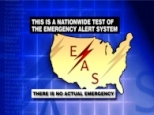 The first national test of a US national alert system left many Americans confused and some said the system failed in its goal to reach all broadcasters in the country.
The first national test of a US national alert system left many Americans confused and some said the system failed in its goal to reach all broadcasters in the country.
Many people watching television at 1900 GMT heard the familiar scratchy noises followed by the test announcement — designed to alert Americans of national emergencies — but others apparently did not.
In the western state of Oregon, KVAL television said it was among several stations in the area which missed the test.
“KVAL TV did show a frame warning that there would be a test, but the test itself was never received,” the station said.
Some viewers in New York said they saw no message at the prescribed time. In the capital city Washington, viewers watching CNN saw the 30-second test and then were inexplicably switched to a shopping channel for several seconds before returning to the all-news station.
Phil Petree, president of the Florida-based safety alert group NeighborhoodWatchAlerts.com, said he monitored several radio and TV stations and found some did not broadcast the alert, and others did it later than the planned airing at 2:00 pm local time.
“One station carried the alert at 2:04, the radio station did it at 2:07 and one station didn’t carry it at all,” he told AFP.
“I don’t know if did this not get carried on purpose or because of an equipment failure.”
The Federal Emergency Management Agency (FEMA) said the test “was the first time we have tested the reach and scope of this technology and what additional improvements that should be made to the system as we move forward.”
“Only through comprehensively testing, analyzing, and improving these technologies can we ensure an effective and reliable national emergency alert and warning system,” a FEMA statement said.
The test is part of the Emergency Alert System designed to transmit, via TV and radio, emergency alerts and warnings regarding weather threats, child abductions and other types of emergencies, according to officials.
While state and local tests already take place frequently, a simultaneous, nationwide test of the national EAS “emergency action notification” code has never occurred before.
Petree said the government is slow in implementing a new system called IPAWS (Integrated Public Alert and Warning System) which can disseminate warnings via newer technologies including the Internet.
“These messages could be on Facebook, or GoogleTalk could push them out,” he said.
“If you’re talking about reaching people with an emergency message… there’s a big part of the population that is not watching television.”
{AFP/Matzav.com Newscenter}












If I never have my radio on and I don’t have a TV, how will this national alert sytem going to reach people like me? I remember as a kid back in the fifties, there were air raid sirens, a hold over from the war years I guess. I would think that would be a more encompassing way of alerting people.